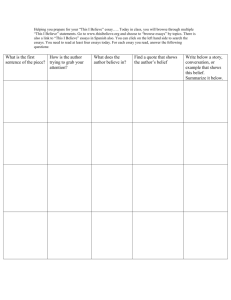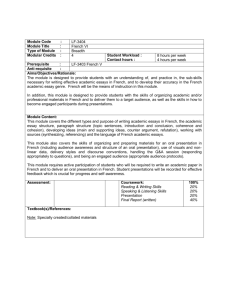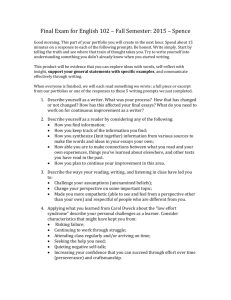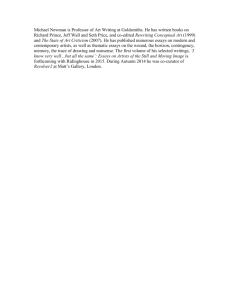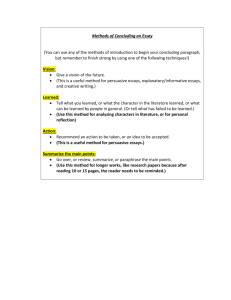The Elements of Fiction
advertisement
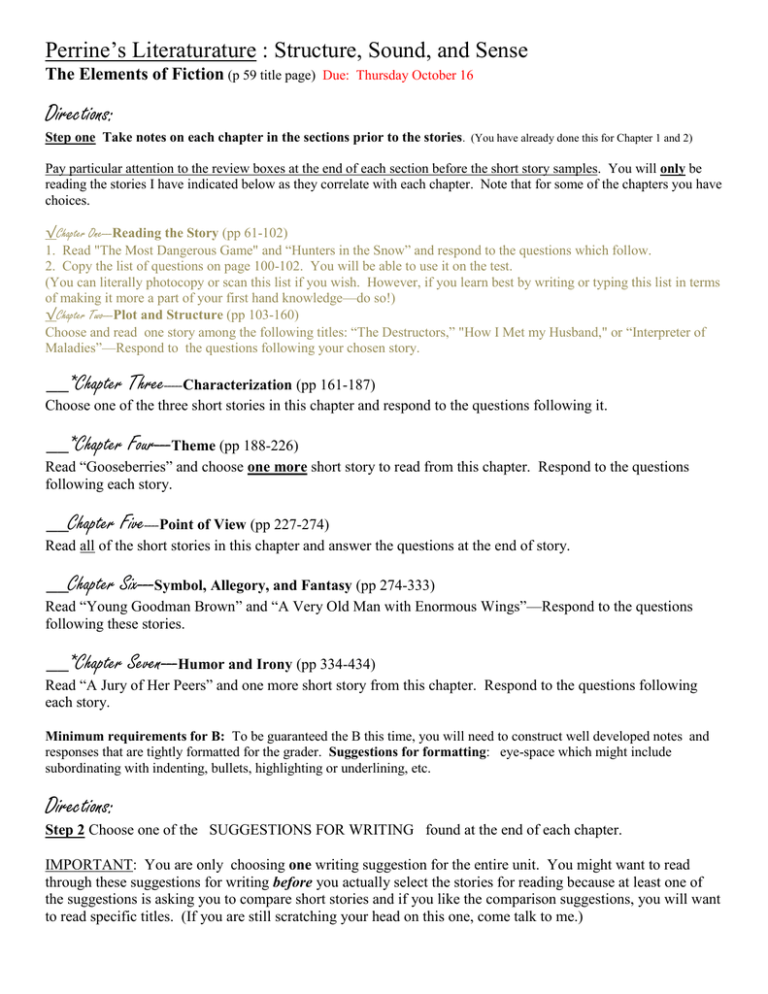
Perrine’s Literaturature : Structure, Sound, and Sense The Elements of Fiction (p 59 title page) Due: Thursday October 16 Directions: Step one Take notes on each chapter in the sections prior to the stories. (You have already done this for Chapter 1 and 2) Pay particular attention to the review boxes at the end of each section before the short story samples. You will only be reading the stories I have indicated below as they correlate with each chapter. Note that for some of the chapters you have choices. √Chapter One---Reading the Story (pp 61-102) 1. Read "The Most Dangerous Game" and “Hunters in the Snow” and respond to the questions which follow. 2. Copy the list of questions on page 100-102. You will be able to use it on the test. (You can literally photocopy or scan this list if you wish. However, if you learn best by writing or typing this list in terms of making it more a part of your first hand knowledge—do so!) √Chapter Two---Plot and Structure (pp 103-160) Choose and read one story among the following titles: “The Destructors,” "How I Met my Husband," or “Interpreter of Maladies”—Respond to the questions following your chosen story. __*Chapter Three-----Characterization (pp 161-187) Choose one of the three short stories in this chapter and respond to the questions following it. __*Chapter Four---Theme (pp 188-226) Read “Gooseberries” and choose one more short story to read from this chapter. Respond to the questions following each story. __Chapter Five----Point of View (pp 227-274) Read all of the short stories in this chapter and answer the questions at the end of story. __Chapter Six---Symbol, Allegory, and Fantasy (pp 274-333) Read “Young Goodman Brown” and “A Very Old Man with Enormous Wings”—Respond to the questions following these stories. __*Chapter Seven---Humor and Irony (pp 334-434) Read “A Jury of Her Peers” and one more short story from this chapter. Respond to the questions following each story. Minimum requirements for B: To be guaranteed the B this time, you will need to construct well developed notes and responses that are tightly formatted for the grader. Suggestions for formatting: eye-space which might include subordinating with indenting, bullets, highlighting or underlining, etc. Directions: Step 2 Choose one of the SUGGESTIONS FOR WRITING found at the end of each chapter. IMPORTANT: You are only choosing one writing suggestion for the entire unit. You might want to read through these suggestions for writing before you actually select the stories for reading because at least one of the suggestions is asking you to compare short stories and if you like the comparison suggestions, you will want to read specific titles. (If you are still scratching your head on this one, come talk to me.) Literary Analysis Rubric: This criteria meets the minimum requirements for the B. ___ MLA format FOLLOW THE GUIDELINES EXACTLY AS STATED IN owl@purdue which includes using a 12 Times New Roman font. Look at the samples this site provides. There will be no room for interpretation for this assignment. Really look at the heading. ___ the name of this essay assignment in the heading should read: Literary Essay #2 ___ a title for the essay that draws the reader in ___ ___ 1.5 spacing ( This requirement is my caveat as it applies to MLA) ___ 700-1000 words ___ quoted material seamlessly integrated into written discussion at least 5 times and no more than 7 ___ basic conventions of writing literary essays which include the following criteria: integrating the title and author appropriately, insightful analysis of the passage (define the effect of the passage and demonstrate how the author conveys the effect (through literary elements) control of rhetoric (state a claim, support and explain it; make specific references to the text) control of conventions (no comma splices or egregious errors in agreement, etc.) control of structure (a well-developed written discussion that logically moves from the introduction to conclusion) AP Scoring Model Top Scores 9-8 50/50 Upper Scores 7-6 45/50 Middle Score 5 40/50 Lower Scores 4-3 35/50 Lowest Scores 2-1 30/50 These are well-written papers which respond fully to the prompt. The best papers show a full understanding of the issues and support their points with appropriate textual evidence and examples. Writers of these essays demonstrate stylistic maturity by an effective command of sentence structure, diction, and organization. The writing need not be without flaws, but it should reveal the writer’s ability to choose from and control a wide range of elements of effective writing. These essays also respond correctly to the questions asked but do so less fully or less effectively than the essays in the top range. Their discussion may be less thorough and less specific. These essays are well-written in an appropriate style but reveal less maturity than the top papers. They do make use of textual evidence to support their points. Some lapses in diction or syntax may appear, but the writing demonstrates sufficient control over the elements of composition to present the writer’s ideas clearly. These essays respond to the question, but the comments may be simplistic or imprecise; they may be overly generalized, vague, or inadequately supported. These essays are adequately written, but may demonstrate inconsistent control over the elements of composition. Organization is attempted, but it may not be fully realized or particularly effective. These essays attempt to deal with the question, but do so either inaccurately or without support or specific evidence. They may show some misunderstanding or omit pertinent analysis. The writing can convey the writer’s ideas, but it reveals weak control over diction, syntax, organization. These essays may contain excessive and distracting spelling and grammatical errors. Statements are seldom supported with specific or persuasive evidence, or inappropriately lengthy quotations may replace discussion and analysis. These essays fail to respond adequately to the question. They may reveal misunderstanding or may distort the interpretation. They compound the problems of the Lower Score papers. Generally these essays are unacceptably brief or poorly written. Although some attempts to answer the question may be indicated, the writer’s view has little clarity and only slight, if any, evidence in its support.
